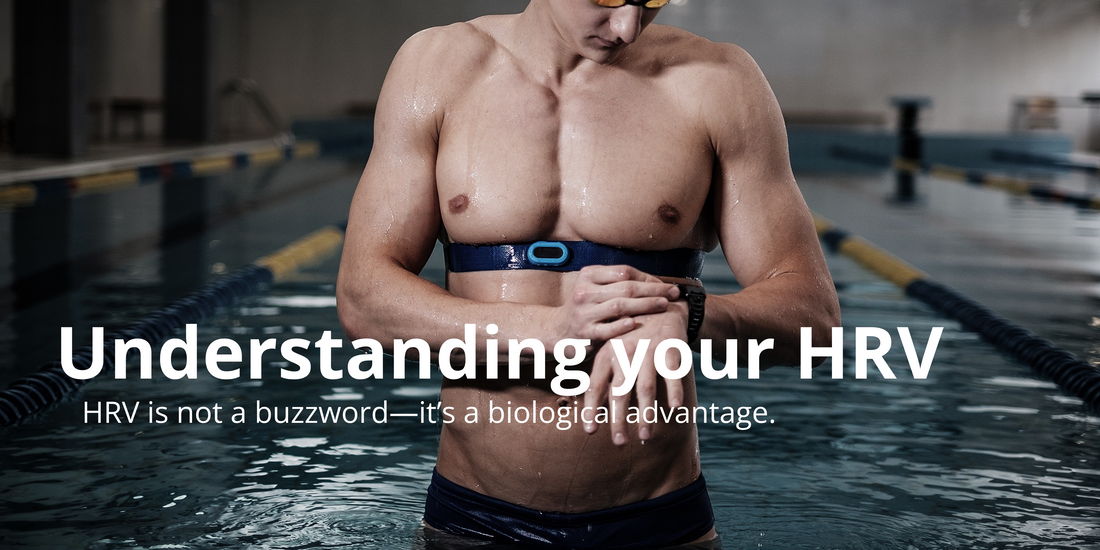
Understanding your HRV
Share
You feel fine. You’re training hard. You’re doing “everything right.”
But you’re still tired. Progress is slow. Your sleep is off, and your energy is unpredictable.
What if your body is trying to tell you something—but you’re not hearing it yet?
That’s where Heart Rate Variability (HRV) steps in—a silent but powerful signal of your body’s internal stress load, recovery ability, and overall resilience.
Whether you’re trying to build lean muscle, reduce inflammation, or simply stay strong and vital through your 40s and beyond, HRV is one of the most valuable metrics you’re not using enough.
What is HRV, Exactly?
Unlike your heart rate (how many beats per minute), HRV measures the variation in time between each heartbeat. It’s a subtle metric that reflects how well your autonomic nervous system (ANS) is functioning—the same system that manages recovery, sleep, digestion, hormone regulation, and cellular repair.
A healthy, adaptable nervous system isn’t robotic—it varies.
✅ Higher HRV = more parasympathetic activity (rest, recover, adapt)
❌ Lower HRV = more sympathetic dominance (stress mode, overtraining, hidden illness)A low HRV doesn’t just mean you’re tired.
It could mean your nervous system is overloaded, inflamed, or fighting something you don’t even feel yet.Why Should You Care About HRV?
Low HRV is linked to:
Higher risk of heart disease and stroke
Poor outcomes in chronic illness
Slower recovery from workouts or injury
Increased inflammation and burnout
Hormonal instability and disrupted sleep
It’s like a check engine light for your body—giving you a chance to intervene before burnout, injury, or illness takes over.
How Is HRV Measured?
Most modern wearables (like the Oura Ring, WHOOP, Apple Watch or Garmin watch) measure HRV using light-based sensors. The most common metric is RMSSD, which reflects how active your parasympathetic (rest-and-repair) system is.
Pro Tip: Always measure HRV first thing in the morning, before coffee, movement, or stress kicks in.
It’s not about the absolute number—your 60ms might be perfectly healthy while someone else’s 90ms is low for them.
It’s about your personal trend. Is it rising? Stable? Dropping?
What Influences HRV (That You Can Control)?
Improves HRV:
Quality sleep
Daily movement and aerobic fitness
Strength training (long-term)
Meditation and breathwork
Cold exposure
High-protein, micronutrient-rich nutrition
Supplementation (like amino acids, electrolytes, and vitamins)
Crushes HRV:
Alcohol (yes, even one glass)
Poor sleep or erratic sleep cycles
Overtraining or chronic cardio
Mental/emotional stress
Inflammation, hidden infections, or poor gut health
High-sugar, ultra-processed diets
Can HRV Improve Your Training?
Yes—if you use it wisely.
HRV isn’t meant to micromanage your workouts. It’s meant to show you whether your body is ready to adapt, or whether it’s still trying to recover.
Low HRV today?
Pull back. Focus on mobility, walking, or breathwork.
Support with extra protein (PerfectAmino), electrolytes, and sleep.
Reflect: Are you underslept? Overstimulated? Undernourished?
Stable or rising HRV?
Green light for intensity. Your system is primed to make gains.
HRV helps you train with intention—not just intensity.
What If Your HRV Is Chronically Low?
That’s a red flag. Even if you feel okay, something could be simmering under the surface:
Hidden inflammation
Hormonal imbalance
Gut issues
Nutrient deficiencies
Poor liver/kidney function
Overtraining
Emotional stress you’ve normalized
This is where HRV becomes a game-changer. It lets you intervene early, course-correct, and avoid bigger issues down the track.
HRV + Longevity Training
Heavy strength training (like 5x5 programs) may slightly drop HRV immediately after a session—that’s normal. But over time, lifting heavy and recovering well leads to higher baseline HRV, better metabolic health, and stronger stress tolerance.
Pair strength work with intentional recovery to support nervous system resilience:
Deep, consistent sleep
Strategic rest days
Smart supplementation (PerfectAmino, electrolytes, whole-food vitamins)
Breath-led cooldowns
Low-impact movement like walking or Zone 2 cardio
The Takeaway
HRV is not a buzzword—it’s a biological advantage.
It allows you to:
Spot trouble before it turns into illness or burnout
Adjust your workouts based on real recovery, not guesswork
Build a more resilient body and nervous system for the long haul
When you combine HRV tracking with smart training, quality nutrition, and recovery rituals, you reclaim control over your energy, strength, and future health.
You don’t have to guess anymore.
HRV puts your health and recovery in your hands.
